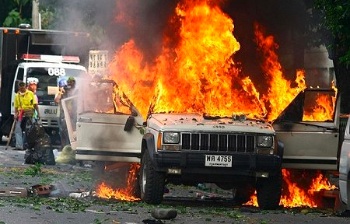[This essay was written for the Media Entertainment & Arts Alliance‘s report Life in the Clickstream: The Future of Journalism [PDF], to be launched in Melbourne today. It was published under the title “Smart brains find ways to spread the message” and trimmed to fit the space available. This version includes all of the extracts from @smartbrain’s Twitter stream which I’d originally supplied.]
Bangkok, 7 October 2008. A Jeep explodes near parliament, killing a man. Body parts are thrown up to 20 metres.
Meanwhile, 5,000 members of the royalist People’s Alliance for Democracy are occupying the Government building grounds — well-organised but largely peaceful. Thailand’s Constitutional Court forced Prime Minister Samak Sundaravej to resign a month earlier, but his successor Somchai Wongsawat is seen as a corrupt puppet. PAD has given him until 6pm to resign. He does not. The car bomb detonates. The ultimatum expires. The demonstration explodes into riot.
Tear gas. Gunfire. 381 injured. Another death. It’s the worst violence in 16 years.
Meanwhile, in Sydney, my ex-pat Thai partner and I are sinking beers. We take our laptops online but not even Thai news outlets say what’s happening now.
Then, using Twitter, we find @smartbrain.
Twitter is a global social message service. Often inane — the world’s weirdest cocktail party — it’s also powerfully immediate. During the Sichuan earthquake it spread news half an hour before the wires.
As tanks roll into the Old City, @smartbrain hops on his bike, just as he’s done throughout the PAD occupation. In 140 characters or less, he reports to his Twitter “followers”.
6.30pm: more army trucks. People are cheering them. I hope they are on our side.
6.31pm: old guy here says it’s not teargas. It’s m79 explosives. Whatever that is.
6.32pm: people being ferried out of rajawiti shout that it’s explosives, not teargas.
6.35pm: screams from the zoo. Monkeys don’t like teargas either.
…
6.45pm: three more trucks with army troops. Can someone please tell me whose side they’re on?
6.51pm: six shots. Wonder where. Shooting at makkawan now? Seven shots.
6.52pm: huge convoy of army trucks.
6.52pm: eleven.
6.53pm: police moving on makkawan. Over a dozen shots now.
…
6.53pm: one shot every few seconds now.
…
7.15pm: three more army trucks. People are cheering them. Still no confirmation who’s side they are on.
7.16pm: army is headed to government house. Either to help or to do a pincer movement with the police.
7.17pm: ok. Army is helping to kill us, the shop vendor beside me says.
7.17pm: confirmed by survivors running from royal plaza. The army is not here to help.
7.18pm: confusion reigns. Vendor beside me is hurling abuse at the soldiers.
7.20pm: i think there are two groups of army here. Those in blue scarves are smiling. Not many though.
…
7.35pm: at royal plaza. Teargas everywhere.
…
7.41pm: is being gassed twice in one day enough? One more round i guess.
He also snaps pictures on his Nokia N95. They’re online in minutes. It’s fast, engaging, and distributed at almost no cost.
We don’t need journalists to tell us “there’s teargas” or “Gordon Brown announced tax cuts” — @smartbrain and @DowningStreet tell us. But we’ll always need journalists to uncover what’s not being said, to interpret, to analyse.
Journalists’ challenge is to create new ways of storytelling. Maybe live Twitter streams will be one of them. Maybe not. But with inexpensive tools and easy distribution, journalism is being liberated from the creaking mechanisms of industrial-age media factories and entering a new golden age.
Further Thoughts
Preparing this essay for republishing online reminded me how the medium frames the message. It was allocated half a page in a printed report, so it was edited not for the needs of the storytelling but according to how many splotches of ink would fit onto a slice of dead tree.
Now I’m not unhappy with the editing. Indeed, I was reminded how a good sub-editor can help focus the words — and the storytelling was improved by leaving out some of the details of Thai politics. However it did mean some of @smartbrain’s tweets disappeared, and I wanted them to stay for this version.
6.52pm: eleven.
… is astounding. One word. By itself it means nothing. In the context of the live Twitterstream, though, counting the gunshots eloquently portrayed the escalation of violence.
7.41pm: is being gassed twice in one day enough? One more round i guess.
… is an example of how this live Twitter coverage ain’t your traditional “objective” journalism. @smartbrain is telling us he’s heading back into the action. A witty remark like this would be frowned upon by any traditional news editor, but it’s engaging — and if we’re engaged by the writer we’ll read what he or she has to say. Isn’t that the aim of the media?


The MEAA report Life in the Clickstream: The Future of Journalism is now available for download [PDF].
Plenty of stuff to comment on, but perhaps I’ll open a new thread for that tomorrow.
Great post — makes your point forcefully but elegantly. One of your most perceptive, IMHO.
Hi — that was a great read! And these technologies are only fledgling. Prepare yourself for a trackback. 😉
You can follow more of @smartbrain’s on http://www.51am.com. 🙂
@yellowdaisygirl: Thanks for the tip. Which contributor is him? 😉 I’ve been using @smartbrain as an important example in how journalism is changing as a result of Twitter and friends, so it’s good to discover more!
He is not only a good example of all techy means he use for journalism, he is also a good example of high level of ethics in his work he provides. 🙂